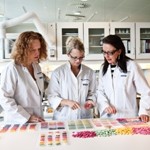Chasing rainbows: Natural colours and supply chain control

A couple of years ago, one industry insider declared the market for synthetic food colours in the UK to be "virtually extinct". Not everyone sees the domestic colours sector in such black-and-white terms, but the trend is clear.
"It would be wrong to say there are no new products going into artificial colours," says European sales director at DD Williamson (DDW) John Calland. "But we do track natural colour launches in the UK, and that certainly seems to be the way forward. After all, retailers have been driving the NAFNAC (no artificial flavours, no artificial colours) agenda for some time now."
Leatherhead Food Research (LFR) puts a value of around $1.55bn on the global food colours market in 2011. Natural colours then accounted for some $600M of this total, representing an increase of almost 29% since 2007.
In value terms, Europe is the largest single regional market for food colours, consuming 36% of all sales, compared with 28% for the US. And within western Europe, the UK is narrowly the single biggest national market, with an estimated 25.6% share in 2011, compared with 24.6% for Germany, says LFR.
The EU has made some progress in clarifying the regulatory situation thanks to its distinction between natural colour additives and colouring foodstuffs. Despite this, the Commission admits that, in practice, these distinctions are not always clear. Moreover, some in the industry continue to use marketing terms, such as 'nature-identical colours' for substances, including beta carotene, where the same chemical composition can be produced via synthesis rather than extraction.
Other areas still subject to regulatory scrutiny in Europe include the extraction processes through which some colouring foods are obtained.
Meanwhile, LFR brackets natural and nature- identical colours together, attributing to them a 60% share ($235M) of the western European food colours market in 2011. The same 60/40 natural/artificial split was true for the UK, it says.
New products captured on the Innova database draw more of a contrast. While 17.18% of UK launches used natural colours in 2012 (compared with just 1.24% using synthetics), the wider figure for the whole of Europe was 13.44% of launches (1.38% synthetics).
Where synthetics are still used, it is likely to be for reasons of colour stability in a product exposed to heat or acidity, for example. As LFR points out, the pursuit of NAFNAC in categories such as confectionery has had a positive effect on sales, suggesting that the drift towards natural colours is set to continue.
Clean-label pull
Even where EU regulations offer little in the way of clarity on a given colour's 'natural' or 'artificial' status, the gravitational pull seems to be in the direction of those options offering the 'cleanest' label. When it comes to the four classes of caramel colour available, says Calland at DDW, that status is open to interpretation. But UK manufacturers would tend to prefer the Class 1 variant involving plain caramel and burnt sugars. "It comes at a higher cost, because of the longer cooking time, and the fact that no food-grade catalysts are used," he explains.
More generally, pricing is an issue inevitably, when you consider that the price of a natural colour can be around 10 times that of an artificial alternative. In practice, differentials may vary depending on cost-in-use. "Above all, you need to bear in mind that colouring agents are likely to account for only between 0.01% and 0.05% of the final product weight," says Calland.
In parallel with this increased attention to the 'natural' credentials of their colours, suppliers and food manufacturers have been looking far more closely at traceability and supply chain security issues for these as for other ingredients.
Specialist suppliers of colouring foods place particular emphasis on these concerns. Says Paul Collins, md of GNT in the UK: "From our perspective, the issues of traceability, authenticity, availability, processing, consistency and performance are inter-related, critical points. These key areas can only be managed effectively by supply chain control a critical element in our competency and business model."
He talks about this level of supply chain control as a form of vertical integration: "When you're dealing with an agricultural or horticultural product, that control needs to go back as far as the farm, or ideally the seed."
Collins adds: "Even for raw materials not grown in Europe, you still need to be able to go down the supply chain to the point of origin. Otherwise, what is the alternative if you buy product processed by a third party on the open market? To analyse it to death? And even then, how would you know what to look for?"
At Chr Hansen, head of product management in the Natural Colours Division, Charlotte Gylling Krusaa points out that all of the firm's sites were certified to the FSSC 22000 quality and food safety standard during 2012. "Traceability from 'farm to fork' is an integrated and important part of our food safety programme," she says. "We can trace raw materials and products really quickly, as a result of our systems and procedures. Speed is of the essence if a withdrawal is required."
She adds: "Our customers regularly ask us to perform a traceability test to ascertain what raw materials are present in what colours. On top of that, we run regular 'mock recall' tests to ensure the continued robustness of our set-up."
Even though Chr Hansen has had this type of procedure in place for around a decade, she says, the focus on a demonstrable track-and-trace capability is stronger than ever.
Vendor management
"Something that has been strengthened over the last 10 years or so is our policy on vendor management, where we audit and approve new suppliers against commercial, corporate social responsibility (CSR) and product safety criteria," Gylling Krusaa states. "We have always had very comprehensive questionnaires, and these are getting even more specific. We require more detail from our partners to ascertain the level they can supply at." This includes, for instance, how they comply with aspects of legislation and how they carry out their processing.
At GNT, Collins says: "We have a quality management system that is audited and accredited to the highest standard. In addition, we have many customer audits throughout the year." All of this reassures customers its products and processes are under control, he adds.
According to GNT, customer audit requirements have not become significantly more stringent in recent years, although the expected standards for accreditations are continuously evolving. "Periodically, you do get asked to issue a statement about colouring foods being free from X or Y. These issues come up, and you deal with them by having traceability and supply chain control."
More often, this supply chain scrutiny is taking on an ethical dimension. "Most of the larger food firms will want to audit the supplier and see evidence of proper upstream audits," says Calland at DDW. "But increasingly, customers are moving towards using systems such as Sedex (Supplier Ethical Data Exchange), which gives a lot of visibility on your supply chain, whether that is on areas such as working conditions, or risks such as child labour."
For its part, Chr Hansen says it has been a member of Sedex since 2009. "It's definitely important for us and our customers to be able to demonstrate our CSR performance with an external certification body, and nearly all our natural colour production sites have passed the audits by now," says Gylling Krusaa.
In the UK, testing group Exova's valid-it system is in demand for genetically modified organism (GMO)-free traceability and broader supplier risk assessment and validation, Calland at DDW adds.
Meanwhile, if anything is slowing growth in natural colour development, it is regulatory and labelling uncertainty (as well as stability issues) rather than cost or supply-chain concerns.
Calland describes a mix of 'push' from suppliers and 'pull' from "more and more customers looking for solutions and suppliers to work with".
Consumer perceptions
GNT claims its commissioned research confirms that colouring foods fit with public perceptions of 'natural colour'. "This is a very important issue," Collins argues. "It's fair to say that the cost-in-use to achieve this benefit by using colouring foods is not something that prevents it being commercially viable or commonly practised."
Says Gylling Krusaa: "Growing demand for colouring foodstuffs is part of the wider mega-trend towards more natural and clean-label products." As she points out, it was Germany that first fuelled demand for colouring foodstuffs, and it continues to drive this market.
There are at least two dynamics here: a move from synthetics to natural colour additives, and a move from additives to colouring foodstuffs. "It's a big single step to take from synthetics to colouring foods," she points out. "Some do that, but mostly it's a two-stage process."
Once there is clearer regulatory definition, suppliers and end users will be even more inclined to see this process less as a leap in the dark and more as a slide into the light.












